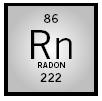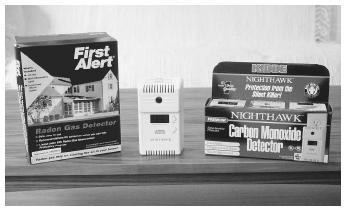Radon

MELTING POINT:
−71°C
BOILING POINT:
−61.8°C
DENSITY:
9.73 g/cm
3
MOST COMMON IONS:
None
Radon is a member of the noble gas family and was the first radioactive gas to be discovered. It is colorless, odorless, and chemically inert (like the other noble gases), but it is a highly radioactive α -particle emitter.
Radon was discovered in 1899 by the McGill University professors Ernest Rutherford and Robert Owens, who found that radioactive thorium produced radioactive gas. They named this gaseous substance thorium emanation, later to become thoron. It was found that radium gave off a similar emanation (radon), as did actinium (actinon), in 1900 and 1904, respectively. Once the structure of the atom and the elemental transmutation process became better understood, it was determined that thoron, radon, and actinon were different isotopes of the same element (radon)— 220 Rn, 222 Rn, and 219 Rn, respectively.
Radon has a tiny natural abundance as the product of uranium and thorium decay; it has a background concentration of 6 × 10 −14 parts per million by volume in air. Because radon is a short-lived α -emitter, the synthesis of compounds that contain radon has been limited to just fluorides and oxides. Radon saw considerable therapeutic use between 1920 and 1950 in the irradiation of tumors, but its modern usages stem from its being an easily detected radioactive gas. It is used to trace gas flow and air movement, and

its presence below Earth's surface can yield information about tectonic movement, earthquake potential, and mineral deposits.
During the 1980s it became recognized that there was widespread contamination of households by radon, which is now estimated to cause 10 percent of all lung-cancer deaths. The primary source of household radon is surrounding bedrock rich in uranium and also present in a permeable matrix that permits diffusive and convective transport of the radon isotopes derived from the uranium. The U.S. Environmental Protection Agency encourages corrective action when household radon levels surpass 4 pico-Curies per liter, yet in some parts of the country more than 40 percent of the residences exceed this value.
SEE ALSO Noble Gases .
Laurence E. Welch
Bibliography
Budaveri, Susan, ed. (1996). The Merck Index: An Encyclopedia of Chemicals, Drugs, and Biologicals, 12th edition. Whitehouse Station, NJ: Merck.
Cothern, C. Richard, and Smith, James E., Jr., eds. (1987). Environmental Radon. New York: Plenum Press.
Internet Resources
"Indoor Air—Radon." U.S. Environmental Protection Agency. Available from http://www.epa.gov .
Comment about this article, ask questions, or add new information about this topic: